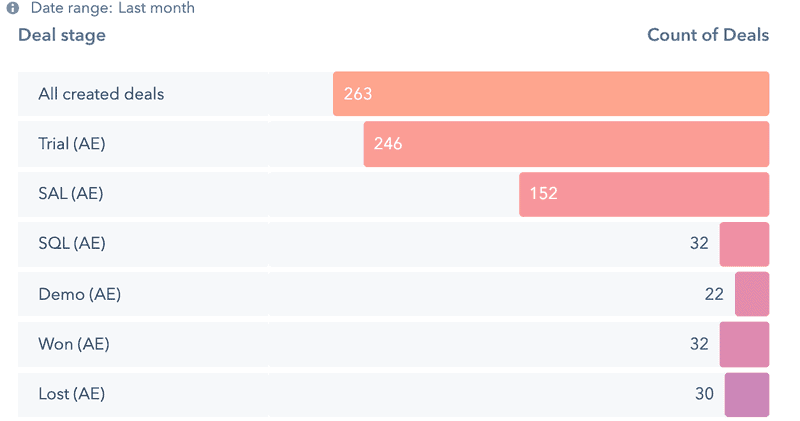TL;DR:
Most conversion rates are actually only displayed on a ‘one-month basis’ in CRMs [see Hubspot below], so a time-series aka. month-on-month comparison approach to funnel analytics would already be an improvement. Nevertheless, the blended conversion rates on those month-on-month comparisons, don’t give actual insights about process improvements or individual improvements made over time.

Time-based cohorts are a powerful tool to measure the performance of reps in an immediate fashion.
Time-based cohorts
When I evaluate the performance of sales reps to identify opportunities for improvement, I focus on the input and conversion rates within a funnel (as seen in my article from June). An important side note is how I think about the conversion rates:
The conversion rates are measured based on the ‘month the deal was created’, which means that when inputting conversion rates for month 0 (i.e. July) I also refresh the numbers of month -1 (June); month -2 (May) etc.

Month-on-month comparison tables
Pros:
- Tactical changes & improvements of the individual become visible and traceable (after some time elapsed)
Cons:
- More work to get insights
- It takes longer to get insights
The solution: cohorts
I can understand everyone that questions whether measuring conversion rates that gain in reliability over time is effective. This form of measurement basically will only give you reliability once you have gone through the average sales cycle time (i.e. 2-3 months).
Hence, I introduced cohorts to have comparable reliable data from the get-go:

You can read it as follows, taking month -10 as an example:
Rep I managed to qualify 75% of the 16 SALs that were allocated into her pipeline that month, into opportunities aka. Sales qualified leads. In month 2, another 3 SALs from month-10 were qualified as SQLs increasing the conversion rate to 93.75%. This number remained stable for another 5 months until she qualified the last SAL into an SQL in month 7.
Impacts of using cohorts
Tracking improvements
The beauty of the cohorts is that you can measure the immediate impact of process improvements:

Take the improvement from month -14 to month -13 as an example. In this real-life example, the rep suggested a process improvement that asked more commitment from the lead in a discovery call. You can see in the first-month comparison that the conversion rate to the next stage, improved by 809%. Plus the ‘time agnostic’ conversion rate doubled. It’s safe to say that it quickly became standard practice within the team.
Quicker insights into performance during sales onboarding
Ramp up time is measured in a weirdly non-effective way, including the length of time someone takes to reach 100% of quota attainment. Depending on your sales cycle this will be a massively lagging indicator of performance. I prefer to see whether certain micro-conversion steps are managed within a certain timeframe, which allows me to predict the success of a new rep or training requirements.
The headache of making cohorts work
I liked digging into the data, which is not necessarily an effective way to scale. Hence I was looking into ways to automate my reports – long story short: very difficult. CRMs don’t offer the reports in their standard stack and dashboarding tools with native integrations to the CRMs can’t present the data properly. Hence, I even started working on automating the cohorts with a friend of mine. For the time being, I suggest that you or your sales operations manager builds those reports manually once per month to experience the value that you get out of it.
Signup for the newsletter here to get more sales management / sales process content:



